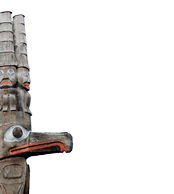 |
|||||||||
 |
|||||||||
 |
|||||||||

Works of Art |
||
Mungo Martin
|
This large mask made of Western Redcedar depicts the Cannibal Bird companions of Baxwbakwalanuxwsiwe’ (Cannibal-at-the-North-End-of-the-World). The largest is Crooked Beak; the smaller are two Cannibal Ravens and the long-beaked Huxwhukw. Mungo Martin made this mask for use in the opening ceremonies of Wawadiťła. An earlier version made by Willie Seaweed for Martin in 1938 is now in the Denver Art Museum. Another version of the mask continues to be a significant privilege of Mungo Martin’s family: his grandson, Chief Peter Knox, uses a contemporary version of this mask made by Knox’s own carver son, David. RBCM 9201. |
|
Copper
|
Coppers function as units of great wealth on the Northwest Coast. This one has a prestigious name – Max’inuxwdzi (Great Killer Whale) – and an important history. It was made by Chief Willie Seaweed and purchased by Mungo Martin from Chief Peter Scow in 1942. On two occasions, Martin broke pieces off the Copper to mark special events. The first time was to neutralize an insult by a rival chief; the second was in honour of his son, David Martin, who died tragically in a fishing accident in 1959. In 1960, Mungo Martin presented the Copper and other regalia to the museum. RBCM 9251. |
|
Mungo Martin
|
This Bee mask was made for the first hamaťsa ceremony of Mungo Martin’s son, David. In this prestigious ritual, young men become possessed by the cannibal spirit Baxwbakwalanuxwsiwe’. Through traditional teachings and ceremonies, they are tamed and brought back as responsible members of civilized society. The carving of this mask is documented in the film Mungo Makes a Mask (1953). RBCM 9227. |
|
Mungo Martin
|
Tambourine drums such as this are made of hide stretched over a circular frame of bent wood. Mungo Martin’s painted design depicting a Kingfisher combines Kwakwaka’wakw graphic conventions with a lively naturalism. RBCM 9216 a. |
|
Mungo Martin
|
This round rattle came into the collection in 1959 and may have been made in the carving program in Thunderbird Park. The dyed Redcedar bark attached to the rattle is a symbol of the ťseka (Winter Ceremonies), of which the hamaťsa dance is the highest-ranking component. RBCM 9197. |
|
Mungo Martin
|
This rattle is similar to RBCM 9197 and would have been used in the ťseka (Winter Ceremonies). RBCM 9198. |
|
Mungo Martin
|
This large and complex mask depicts a Sandhill Crane. The crane’s neck and wings are articulated; a human face forms the body of the bird. Mungo Martin made the mask while working in the carving program at Thunderbird Park. Its distinctive style reflects the artistic traditions of his home community, Tsaxis (Fort Rupert). RBCM 9250. |
|
Mungo Martin
|
||
Mungo Martin used these brushes when he was Master Carver in Thunderbird Park in the 1960s. Like all of his carving tools, they were custom made in the traditional manner with traditional materials. RBCM 12611 a, b. |
||
Mungo Martin
|
Like much of Mungo Martin’s work, this beautifully executed model combines traditional Kwakwaka’wakw designs with a dynamic naturalism. Here, two figures propel a river canoe with long poles, while two paddles rest in the canoe. The carving was once the property of an American private collector who sold it at auction in 1979. RBCM 16439 a-c. |
|
Canada Council Medal
|
The prestigious Canada Council Medal honouring outstanding achievement in the arts in Canada was awarded to Mungo Martin posthumously in 1964 in recognition of artistic excellence as well as his significant role in documenting and continuing the songs, ceremonies and traditions of his people. He was the first aboriginal artist in Canada to receive the award. RBCM 13789 a, b. |
|
| Back to Mungo Martin |

